Mutants & Masterminds: Golden Age by Fossilized Rappy
A Brief History of Nazi-Punching
Original SA postTasoth posted:
Alternity's art being awesome doesn't stop there. Both of the alien guides have covers by Brom and the actual illustrations are top notch. God do I love those books.
Meanwhile, it's time to do the opposite of April Fool's day tradition and actually write up what I said I would enter the new thread with, plowing straight through the first two chapters of Mutants and Masterminds: Golden Age. Excelsior!
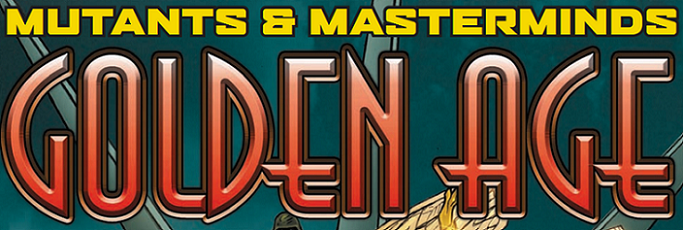
Introduction and Chapter 1: A Brief History of Nazi-Punching
What is Mutants and Masterminds?
Assuming you don't already know about it somehow, Mutants and Masterminds is a d20 system game focused on two things: superheroes, and saying
 to the sacred cow of character classes. Instead, you buy your ability scores, skills, feats, and powers with a pool of points alloted to you based on the game's "Power Level". Like Dungeons and Dragons, d20 Modern, and Pathfinder, it has a
System Reference Document
for all your basic rules needs.
to the sacred cow of character classes. Instead, you buy your ability scores, skills, feats, and powers with a pool of points alloted to you based on the game's "Power Level". Like Dungeons and Dragons, d20 Modern, and Pathfinder, it has a
System Reference Document
for all your basic rules needs.
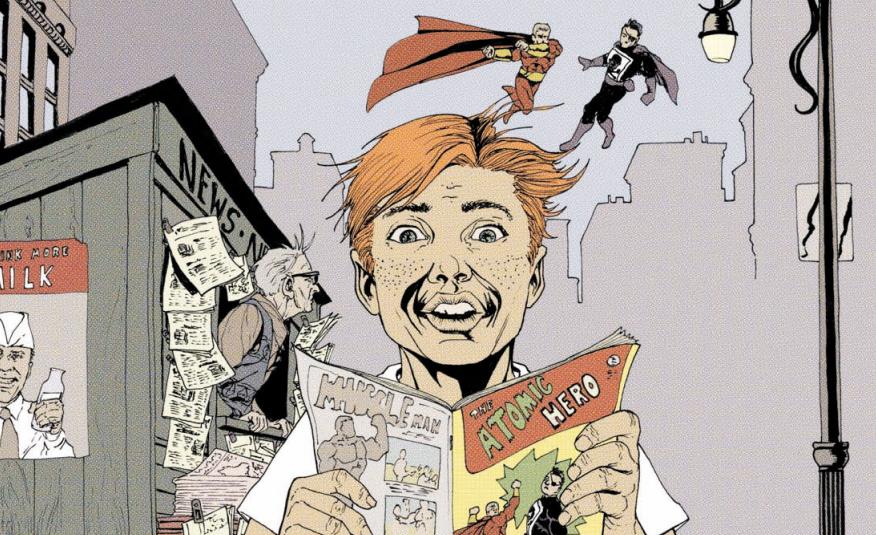
That face.

What is "The Golden Age"?
Chapter 1 of Mutants and Masterminds: Golden Age handily decides to lay down for us the history of the Golden Age, thus explaining what it is to those who are not comic book nerds. The Golden Age is the era of comic books from the first costumed hero in the early 1930s up to an undefined time soon after the end of World War II and the beginning of the Cold War. This is the time where now-famous superheroes such as Superman, Batman, Wonder Woman, Captain Marvel, Captain America, and Namor the
Chapter 2: The Golden Age World
Just as the first chapter was an overview of the history of comic books during the Golden Age, chapter 2 is an overview of the rest of the world during the Golden Age.
A Brief Overview of America at War
If you didn't know, there's an obscure event during the Golden Age called "World War II". This first segment covers both that and the Korean War in broad strokes. There is a game-relevant sidebar entitled "They Saved Hitler's Brain!", however, discussing the various ways you could allow the players to have repeated cases of Hitler-punching even after the war is over.
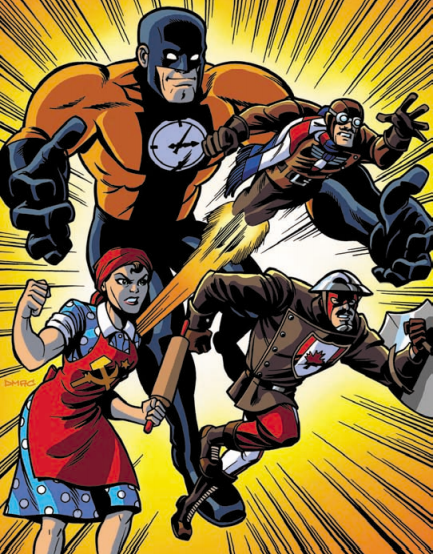
Not quite the World's Finest, but they'll do.
The Golden Age and Real-World History
It all started with the Great Depression. ...Well, this chapter does, at least, beginning with an overview of how the Great Depression lead into the rise of American Nazis and the Cosa Nostra gangsters, as well as the beginning of World War II. Like how America won the war (and those other guys too I guess).
"Mutants and Masterminds: Golden Age posted:
The combined Axis powers were simply no match for America’s industrial might, which simultaneously kept the Soviet Union equipped, the United Kingdom fed, and buried Nazi Germany and Imperial Japan beneath a rain of steel.

What exactly does all of this mean for your supers game, though? Golden Age has the answers for you. The author is quick to note that you could do a Film Noir-style campaign focused around facing off against La Cosa Nostra, a redemption story of an individual who turned to villainy during the Great Depression seeking to become a hero, old villains becoming new allies against the greater threat of the Axis powers, and having Axis supervillains do over-the-top Golden Age things like breaking a famous Hollywood starlet's legs because mwuahaha evil.
Perhaps more interesting than Nazi Punching 101 might be the statements on what to do after WWII ends and the Golden Age begins to wane. The simplest suggestion given is to just replace Nazis with the Red Army as villains, though this might bring up obvious questions about WWII Soviet supers suddenly being treated as the villains. There are also some more interesting suggestions, such as having the enemies present be the extraterrestrials that ushered in the Silver Age of Comics or even McCarthyite finger-poiners hassling the heroes and making their life hell.
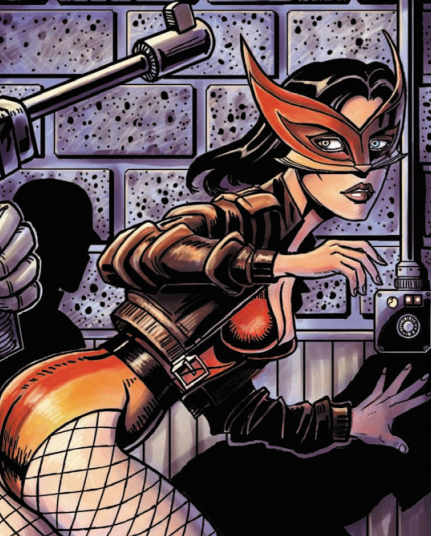
Life in the Golden Age
Ignoring minor notes such as fashion trends of the time, the biggest elephant in the room of talking about how life was in the time of the Golden Age of Comics is that people were often even more bigoted assholes than they are today. The chaptr proudly tells us that the correct way of playing with this fire is that the truth is in the middle:
"Mutants and Masterminds: Golden Age posted:
The key, as always, is balance. Don’t rant on the Nisei internment camps so much that you forget to include the 442nd Regimental Combat Team. As bad as segregation was, don’t forget to celebrate Joe Louis and Jackie Robinson. It was an age that gave us both Charlie and Joe McCarthy–don’t let either extreme dominate your stories. Most of all, don’t lose sight of the fact that this era–like all others–had its good times and bad times, its heroes and its villains. Even in a roleplaying game about bulletproof super-mutants who can fly, a world that is painted as all good or all bad pushes the bounds of credibility too far
"Mutants and Masterminds: Golden Age posted:
It’s vital for the Gamemaster to remember that roleplaying games are supposed to be fun, not long, nasty historical polemics. Though it may be anachronistic, it’s often better to discard elements of the era’s bigotry than to irritate and offend the players.
The rest of the segment is just a look at popular radio and television entertainment, technology, and economics of the time. There's even a table of difficulty checks for obtaining rationed goods if you are that
 about the topic.
about the topic.
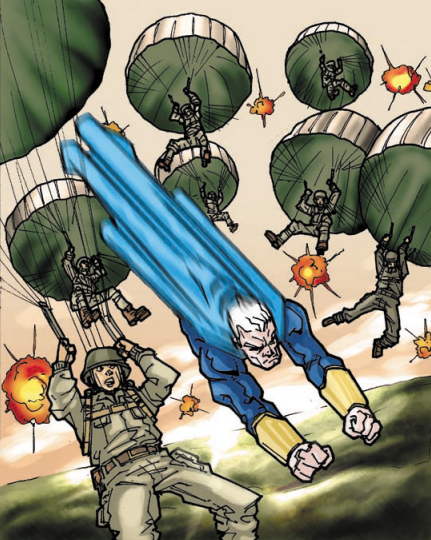
Heroes in Uniform
The final piece of chapter 2 is a brief statement on having an action military campaign set in the Golden Age. This is basically Blackhawks or (for a more modern example) GI Joe: the Campaign. You have above-average but below-superpowered heroes who engage both in action hero-style combat and help rebuild the lives of the people affected by war. There are also statements on crossing such a campaign over into supers territory, such as having a large team of action heroes fight a single war-time supervillain against the odds, introduce Weird Wars-style occult warfare, or the like.
---------------------------------------
Next time: Rocketeers, why you can't be a psychic in the Golden Age, maxing out your Hitler-punching stats, and other game rules for the Golden Age.
Optimized Hitler-Punching
Original SA postBitchtits McGee posted:
For those who came in late: Talents are like highly specialized mini-Feats that you can only take at character creation to supplement your character concept. I, uh, can't think of anything else to say about them, so...
Ryuujin posted:
See Dimwitted but Mighty kind of sounds fun to play, just like some of the races occasionally sound interesting. But then everything devolves into FIIIIIIIEEEEEEEELLLLDS!!tm
quote:
Billy the Yakuza turned curiously at the strange whining sound, and caught an arrow through the throat. As he lost bladder control and crumpled to the ground, he marveled at how little the wound hurt. Billy the Yakuza died without a sound and a brainless look of mild surprise on his face. Within two seconds two other Yakuza leg breakers joined him, their blood lapping against the parked silver H2’s tires like red waves on a red beach.
Let's speed away from the topic of Fields, though, to one much more fun: Hitler-punching!

Chapter 3: Optimized Hitler-Punching
"Mutants and Masterminds: Golden Age posted:
This chapter will have you slapping the lips off fascist dictactors in no time.
As stated before, Mutants and Masterminds uses the concept of "power levels" instead of classes to inform how much points you can buy stuff with. This chapter starts off by noting the different power levels that a Golden Age game will have. Long story short: a fair range of them in multiples of two. Power Level 6 action movie-type heroes, PL 8 "punch stuff really good while wearing tights" heroes, PL 8 Flash/Green Lantern/etc.-type heroes, and PL 12 Superman/Captain Marvel-type heroes are all Golden Age staples, and the book notes that most hero team-ups of the era tended to actually have at least one representative from each power level. These heroes are most likely going to be putting their ranks into physical skills rather than mental skills if you are looking for what the book calls "authentically retro characters". Brawn was supposedly as popular or more popular than brains in heroes of the time...or so this book tells us, at least.
Feats
There is a brief skills section in this title, but it is pretty much just a note that the Computer Use is nerfed to hell in the Golden Age and that the Survival skill can be - gasp - used in urban environments to scavenge things rather than just in the wilderness to find nuts and berries. As for feats, they start out wit an exemplary list of exemptions. Want to be exempt from the draft? Take a feat. Want to be exempt from rationing rules? Take a feat. Want to have positive rather than negative amounts of wealth? Tak-you get the idea. There is also a feat you can take to have a beneficial military rank, one for driving a vehicle in combat without screwing things up, and one for flying a plane in combat without similarly screwing things up.
Powers
Yet again, we have a section that begins with talk about what is and is not good for the "authentically retro character". First off is a no-go on psychic powers and anything too super-sciencey. Why? According to the author of this little tome, the first is because mesmerism was almost always a villain trait in the Golden Age, while the second is because kids at the time were unlikely to understand what things like vibrating super-speed or spatial distortion were. I'm sure that obscure Golden Age heroes known as the Flash and Dr. Occult might disagree on at least two of those points. Second, you should have powers related to punching things. Punching things is always better in the Golden Age. Third, you should only have a few drawbacks, if any, as the heroes of the time were meant to be larger than life. As for new powers, there aren't any. Sorry if you wanted some.
Devices and Equipment
This section doesn't really have much in the way of new material so much as classifying what would and wouldn't be common weapons or vehicles in the Golden Age. it does, however, have this image that could not be skipped:
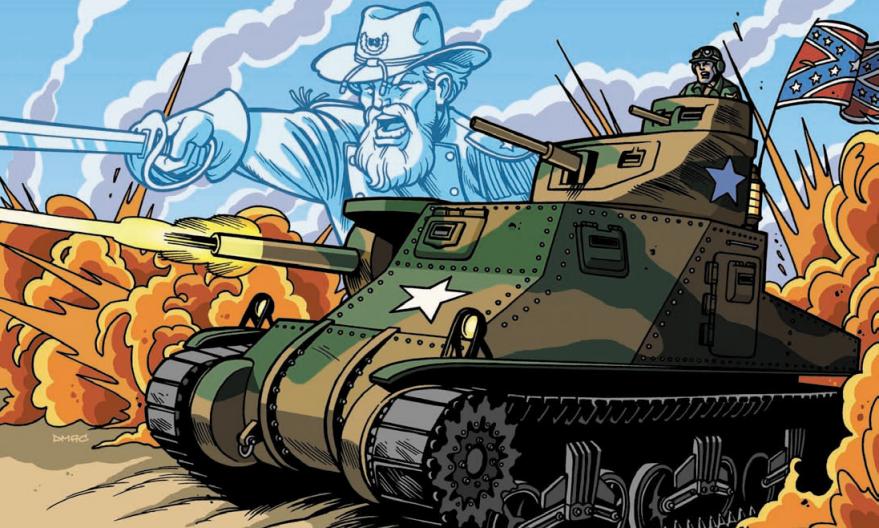
Broncosaurus Rex is over, yet the Confederates still refuse to stop following me.

Hero Archetypes
Last, but not least, are some free archetypes for you to use. These can be used as either NPCs, pre-made PCs, or as springboards for your own character designs. We have - in total in M&M: Golden Age:
-
Masked Adventurer:
This is pretty much straight-up classic Batman or the Green Hornet, being an archetype for a wealthy guy who moonlights as a vigilante.
-
Mystic Adventurer:
A character who gets magical powers from a supernatural object, like the original Alan Scott Green Lantern.
-
Omnipotent Mystic:
An uber-powerful Superman-level magician who is somewhat detached from humanity. I'm honestly not sure who this one is a reference to, as characters like Dr. Occult have more in common with early Harry Dresden than Dr. Manhattan as far as jobs and power levels go.
-
Patriotic Hero:
Captain America, the Fighting Yank, US Jones... The archetype of an all-American human of peak perfection was very much an in thing during the Golden Age, and it's no surprise it ends up in the book.
-
Retro Gadgeteer:
The archetype of flying rocketeers and the like, such as the comic book character Bulletman or the serial story character Commando Cody.
-
Superhuman Hero:
Superman, if you somehow couldn't guess.
-
Two-Fisted Adventurer:
The spiritual ancestor of Indiana Jones. These individuals specialize in Hitler-punching to an extent that only Patriotic Heroes can dream to match.
- War Hero: An action-adventure stylization of an otherwise normal soldier, such as Blackhawk and the Blackhawk squadron.
==========================================
Next time: Stats for Hitler, evil aliens, fly-Cthulhu, and more in the Game Master's chapter.
That Hitler You're Supposed to Punch
Original SA post
Chapter 4: That Hitler you're supposed to punch
Mutants and Masterminds: Golden Age posted:
While it's important to keep in mind the actual history of the era, its many complexities should not be allowed to get in the way of true Good, pure Evil, and their chosen costumed representatives.
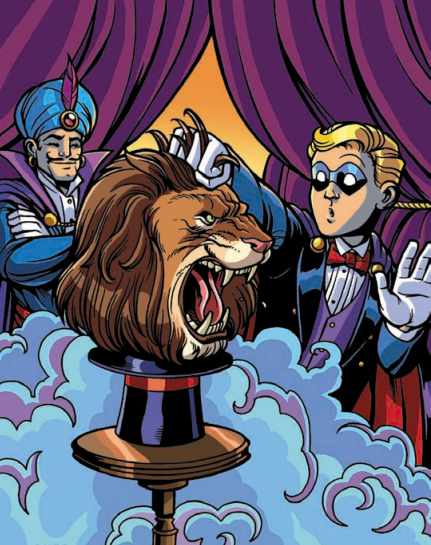

The discussion of superpowers and sidekicks are similarly colored very specifically. Heroes prefer to just punch people rather than actively use their powers if they can, while sidekicks are meant to either accentuate the hero or be doofy comic relief. The book seems to be unsure as to what to do about comic relief characters, though. One the one hand, they discuss how comic relief sidekicks and characters were really popular in the Golden Age to draw the attention of kids. On the other, it drones on repeatedly about how stolen slapstick gags and casual racism were the main repertoire of such characters and probably don't work for a modern audience.
If you really, really want to play Watchmen, though, don't feel left out. The book is here for your Alan Moore needs as well. The suggestion is more or less "don't do as we said earlier": swap out the patriotic longjohns for nationalist dicks, have lots of crime and violence, showcase the racism and bigotry of the time, and go get the Iron Age sourcebook.
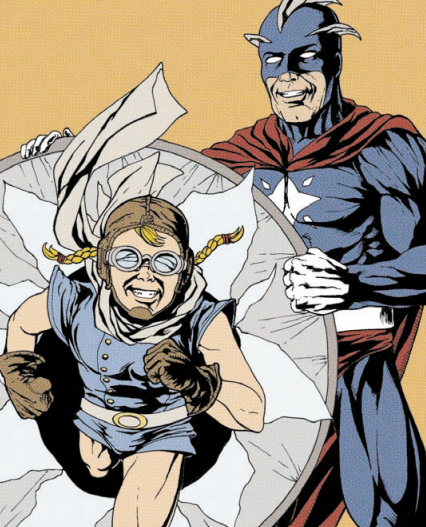
Supporting Cast Archetypes
Or, as other games like to call them, generic NPCs. Let's take a look at them, shall we?
-
Airman:
A generic World War II fighter pilot. He's not exactly a powerhouse of stats by any measure, but he's spammed his character points into Profession (Airman) and Pilot to be somewhat useful if you need a flyboy character in your game.
-
Costumed Sidekick:
Very early Bucky or Robin. This is a premade low-cost sidekick NPC for you to use if you want your own mini-me with their own mini-your-gadget that inevitably gets into more trouble than they will help you with.
-
Non-Costumed Sidekick:
Pretty much Jimmy Olsen. The brief fluff text says that this archetype is meant to be used as the "nosey girlfriend" or "bumbling man-child". They're even cheaper than a costumed sidekick and somehow even more of a bumbling loser.
-
Soldier:
A generic soldier that is meant to have less gadget experience and more raw survivalism compared to the standard soldiers of Mutants and Masterminds.
-
Fifth Columnist:
Illinois Nazis. These are meant to either be used as spy set-pieces or as group saboteurs ready to be stopped by a valiant hero.
-
Mechanic:
That guy you get to fix stuff.
-
OSS Agent:
These stats are meant to reflect a gadget-laden spy of some sort, be they actually from the US Office of Special Services or from some entirely different (and possibly antagonistic) country.
-
Partisan:
A resistance movement member, best used in lower-power military campaigns as a valuable insurgent ally.
-
Der Fuhrer
 While having pretty average stats, he's crunched into the min-maxing cookie, putting an overly large amount of points into Intimidate and Perform (Oratory) and buying feats that let him compel people without actually having a high Charisma score. The flavor text also basically says to do whatever you want to the stats presented, from villainous superpowers to having minions and gear beyond what a character of his low Power Level could conceivably buy.
While having pretty average stats, he's crunched into the min-maxing cookie, putting an overly large amount of points into Intimidate and Perform (Oratory) and buying feats that let him compel people without actually having a high Charisma score. The flavor text also basically says to do whatever you want to the stats presented, from villainous superpowers to having minions and gear beyond what a character of his low Power Level could conceivably buy.
-
Elite Soldier:
A soldier with a higher Power Level. Yaaay.
- Wonder Dog: The third stat block specifically labelled as being used for a sidekick, the Wonder Dog is the springboard for animal sidekicks in general. Sure, it may not be able to talk or manipulate objects, but it's still more likely to help you out of a tight spot than either of the comedy-oriented human sidekick archetypes.
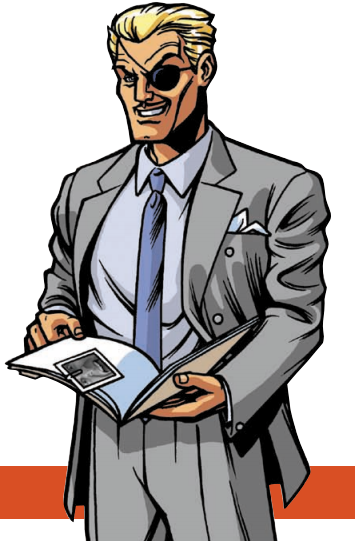
"Ha ha! Questionable art originality."
Villain Archetypes
Like hero archetypes, but with villains.
-
Alien Invader:
Giant, telepathic, death ray-toting aliens straight out of the Golden Age-Silver Age time boundary. He went crazy on his point buy, with all of his scores except Dexterity and Charisma being in the 20s, and death rays aren't exactly something to scoff at. I can't really think of any Golden Age examples of this archetype off of the top of my head, given that they are very much a Silver Age thin.
-
Evil Mentalist:
The mental giant with more Intelligence and Wisdom points than you can shake a stick at and a repertoire of psychic powers. Wonder Woman had a fair amount of these guys as villains in the Golden Age, including the rather bluntly-named Doctor Psycho.
-
Malevolent Magical Entity:
Cthulhu, right down to the archetype art.
-
Master Spy:
A Power Level equal to some costumed heroes equals a spy who has a lot of skills and feats.
- Mob Boss: The archetype Golden Age Batman or Dick Tracy villain. He's not exactly what you'd call high power, but in his ring he's got both clout and a nasty Tommy Gun proficiency.
---------------------------------------------
Next time: The Golden Age in M&M's Freedom City setting.
Hitler-Punching in Freedom City
Original SA post
All this talk of AD&D makes me wish Wizards of the Coast would release PDF versions faster. They have already started repopulating 3E and AD&D titles into the PDF circuit, but a lot of things I'd personally love to get a hold of such as The Sea Devils are still in the pipes. Of course, I'd really love a release of some of their non-D&D property in PDF form as well, especially Alternity and d20 Modern.
That's quite unrelated to my current review, though, so let's get on track.

Chapter 5: Hitler-Punching in Freedom City
Freedom City is the de facto setting Mutants and Masterminds plays in. I don't have the Freedom City Sourcebook, however, so I'm afraid it's a bit of a SOL situation as far as that field goes. I'll try to deal with the Golden Age Freedom City chapter nonetheless.
In Freedom City's Golden Age, the proliferation of supers goes from occult figures in Germany and Japan to the first costumed fighters in America and then to costumed fighters across the board. The first superhero team, the Liberty League, gets founded in 1941 by Roosevelt himself. The actual events of World War II are pretty much the same as in real life, as are those of the Korean War. The end of the Freedom City Golden Age is marked by the disbanding of the Liberty League and growing fear of a secret invasion by the shapeshifting extraterrestrial
Skrulls
Grue. After a brief timeline of these events, we immediately get into game statistics for the dramatis personae of Golden Age Freedom City.
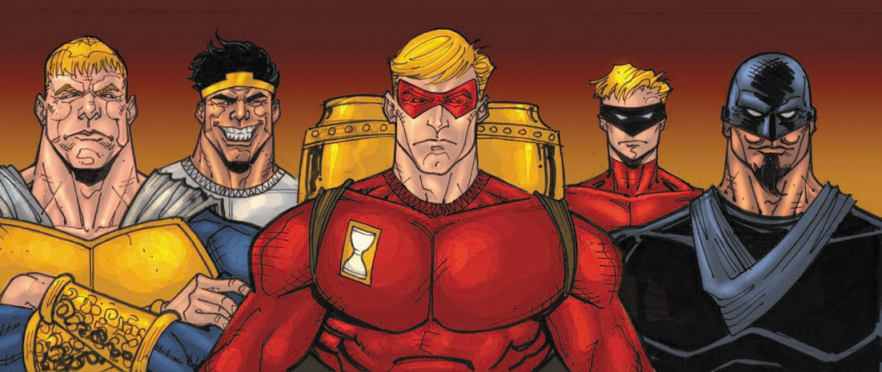
The Liberty League
-
Bowman and Arrow:
The fellows on the far right and second-to-right of the image, respectively. They are pretty unabashed Green Arrow and Speedy expies, right down to some of the more ridiculous trick arrows they have in their arsenal.
-
Centurion:
The squash-faced hero on the far left, Centurion is a Superman analogue that comes from an alternate universe planet of high tech super-Romans.
-
Dr. Tomorrow:
This gadget-based rocketeer hero comes from 2002 in an alternate universe where the Nazis took over the world, Conveniently, an evil Nazi from the same alternate future happened to get teleported to the Freedom City universe with him, keeping Dr. Tomorrow from simply just leading the Allies into a swift victory with his future knowledge.
-
Envoy:
Creepyface up there is Sarlyn, AKA Envoy, a male Golden Age Amazon analogue. He comes from the wondrous civilization of Utopia Isle and has an orichalcum staff as his unique weapon.
-
Freedom Eagle:
Hawkman but with more 'Murica.
-
Johnny Rocket:
Golden Age Freedom City's Flash, Johnny Rocket got his powers from being dunked in experimental rocket fuel.
-
Lady Liberty:
A character that basically picks up whatever Wonder Woman traits weren't put on Envoy. In addition to having most of the classic Wonder Woman powers, Lady Liberty also loses her powers when in bondage.
-
Midnight:
Batman with a darkness-producing "night gun" instead of Batarangs.
-
Patriot:
The Captain America analogue for GAFC.
- Siren: Basically Black Canary with Namor's Atlantean abilities added on.
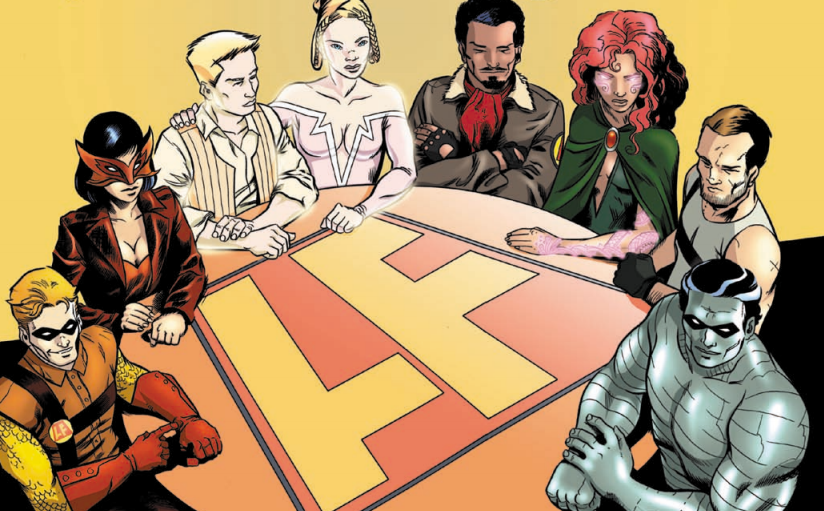
The Allies of Freedom
-
The Human Tank and Gunner:
Brothers and partners in crime, the Human Tank is basically X-Men's Colossus and Gunner has the ability to heal by being shot with bullets or create and shoot bullets back at the enemy. Both of them became Japanophiles as the war ended and then ironically got killed by a Japanese assassin named the Crimson Katana. Wa wa waaaa.
-
Lady Celtic:
A British mage who got her spells, flight, and force field powers by touching a mummified druid. Her life kind of sucks, as she was disowned by her fundamentalist Anglican father and eventually got axed by a Thule supervillain while acting as the party healer.
-
Le Renard Rogue:
A French freedom fighter who relies on her wits and mastery of disguise rather than any superpowers. Like Lady Celtic, she got axed by the Thule Society's croneys when she was weakened.
-
Sergeant Shrapnel:
A soldier whose powers are stalling vehicles and making huge shrapnel explosions. He also died to the Thule, though it's not stated whether or not he died in a really stupid way.
-
Spitfire Jones:
A British RAF pilot who attained the powers of flight and super-strength. Got one-shotted by the same Thule supervillain that killed Lady Celtic.
- White Rose and White Thorn: Twin brother and sister with light powers that act as the token good Germans for the Allied superheroes. Both died as martyrs against the Thule.
Other Allied Heroes
A collection of heroes that either just use archetype stats or were in the Freedom City Sourcebook. The only noteworthy one to me is Codename Kilroy, a character using the Master of Disguise archetype who was known for leaving his eponymous symbol all around the warzones of the world as he traveled.
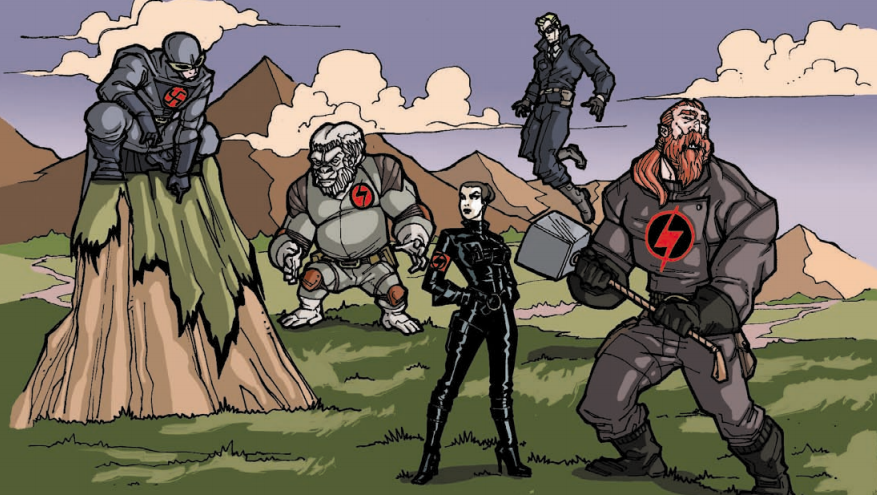
Die Übersoldaten
Just as the Liberty League is the main All-American Allies squad, Die Übersoldaten is the primary Axis supervillain team.
-
Dr. Geistmann:
An evil scientist from the same alternate future as Dr. Tomorrow, Dr. Geistmann happened to get his essence placed into an albino gorilla to let him act as a Nazi version of Gorilla Grodd.
-
Donar:
A Nazi version of Marvel's Thor. After the spirit of the thunder god was freed from being bound to a Nazi, Donar was executed by electric chair because everybody loves irony.
-
Die Eule:
A crazy Austrian gadgeteer clad in a gliding suit and wielding smoke bombs and boomerangs. He has a bit of "evil Batman" to him, but is one of the more original NPCs in this title.
-
Madame Blitz:
A supervillain and part-time romancer of Allies who has electromagnetic powers.
-
Roter Adler:
A generic flight-obsessed flying super.
-
Sea Wolf:
Definitely
the
most unique NPC in this title. Sea Wolf is a German warrior who was cursed by a Roma and Atlantean Deep One magic into becoming an amphibious werewolf. He sure is...something.
-
Totenkopf:
Totenkopf is a villain that is more or less Red Skull with an added poison aura.
-
Die Walküre
A German warrior woman with the power of a valkyrie bound to her. Unsurprisingly, she happened to be the shield maiden and lover of Donar.
-
Schlasbringer:
A disturbing supervillain who decided that working in the death camps wasn't enough, and decided to use his toxin resistance and mastery of poisoning to go around spraying chemicals into enemy battalions.
- Wilhelm Kantor: While possessing no superpowers, Kantor is one of the most dangerous of the Übersoldaten thanks to his massive mental skills and knowledge of the occult. He also wears a gray Klansman outfit, because why not.
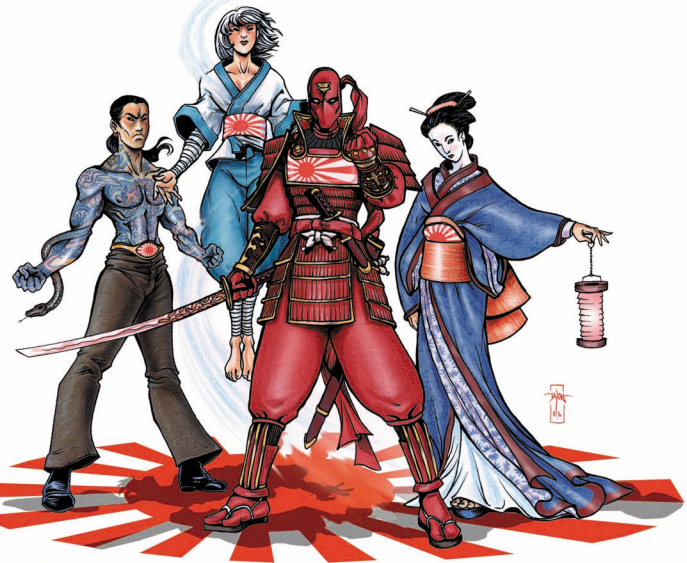
Hinomaru
The Japanese equivalent of the Übersoldaten. They are less stocked with supervillains than most, as the book states the Nazi occultists weren't really keen on sharing and the magic aura of Japan itself seemed opposed to the Axis.
-
Crimson Katana:
The Crimson Katana is a samurai-ninja-mystic with a magic super-strong katana.
-
Geisha:
A femme fatale with superhuman Charisma and emotion-affecting pheromones.
-
Irezumi:
A Yakuza who has the power to summon beasts from out of his tattoos.
- Kamikaze: Taking inspiration from the literal meaning of the term, this NPC is more or less an American-hating Japanese version of Storm. She is the only member of the Hinomaru who didn't survive the end of World War II, as she was in Hiroshima when the bombs dropped.
Other Golden Age Villains
This brief list has no actual stats (or either use archetypes or only have stats in the Freedom City Sourcebook), so it's pretty much just a collection of ideas if you don't want to have Japanese or German foes or are on the very early or very late ends of the Golden Age.
-
The Crime League:
A rather bluntly-named group that are known as the very first supervillains of the Freedom City setting. Like the Liberty League they fought, they were based out of the USA and had a variety of individuals such as
Captain ColdDr. Zero andSolomon GrundyTom Cyprus.
-
The Grue Unity:
As stated before, the Grue are Gray aliens mixed with Marvel's Skrulls and act as the big bads of the time where the Golden Age lapses into the Cold War. Their shapeshifting agents are supposedly the ones that stirred up the Red Scare and made McCarthy the crazy witch-hunter we know him as.
-
The Invisible Empire:
A group of fascists who want to take over America, but aren't directly allied with the Axis forces.
-
The Mycanoids:
Giant humanoid mushrooms that spread from planet to planet on the solar winds. They use the Alien Invader archetype from this book and have a colony on Venus.
-
The Widow:
An Italian master spy. She uses the Master of Disguise archetype, just like her arch-rival Kilroy.
- Alien-Gator: A random humanoid alligator that may or may not be an alien and may or may not have died in its only appearance in a fight against Freedom Eagle during 1950. No idea why it's even on the list.
Chapter 6: A Hitler-Void Adventure
The final full and proper chapter of Mutants and Masterminds: Golden Age is an adventure. Since I'm not really the adventure type, I'll just sum it up briefly as "that adventure where
---------------------------
Next time: We finish off Mutants and Masterminds: Golden Age with the Field Battle System Rules appendix and final thoughts.
Hitler-Status: Punched
Original SA postEvil Mastermind posted:
The "current" Freedom League does have the next-generation versions of Johnny Rocket and Siren. According to the Freedom City sourcebook (the first edition of which is probably the best superhero citybook I've ever read), Dr. Tomorrow vanished three days after VJ Day in 1945, and Centurion died fighting Omega, the setting's Darkseid-equivalent.
 ", though, so I didn't really take the time to write them down.
", though, so I didn't really take the time to write them down.
The only really noteworthy one is that apparently the second Crimson Katana may have made a new blade out of the Human Tank's corpse.


Appendix: Group Fighting
The final bit of Mutants and Masterminds: Golden Age is the Field Battle Rules. The FBR is a system set up to allow for a handful of heroes to fight entire armies without having so many foes you lose your marbles keeping the tab on hundreds of NPCs. It does this by condensing a whole group of individuals into a single stat block whose power is based on several factors. Unit size ranges from a squad of 10 inividuals to an army of 20,000 to 50,000, providing a "Force modifier" of +3 to +14 depending on size to attack, damage, and Toughness, while the quality of a unit – green, trained, or veteran – has its own specific bonus to the attack, damage, Toughness, Defense, Initiative, and Morale of the unit. It's not the only mass combat rules Green Ronin Publishing has done, but it's probably the most straightforward.
Final Thoughts
Mutants and Masterminds: Golden Age in a nutshell: it certainly isn't a bad sourcebook, but it caters to a very specific crowd. It's for the crowd who wants data on the Golden Age or military feats and rules. It's not for someone who wants to do a faux-Golden Age like Watchmen unless they happen to also have Iron Age, it's not for people who want a lot of shiny new powers, and it's definitely not for people who can't take a fair amount of cheese and homages.
----------------------------------------------------------
Next time: Well, there's a fair amount I want to do sooner and later. D&D in World War II, a myriad of post-apocalyptic settings, Japanese monsters, extraterrestrials, Maztica, maybe something from GURPS, the list goes on and on...
I should probably finish up what I started and do the bestiary for Supernatural: the RPG first, though.